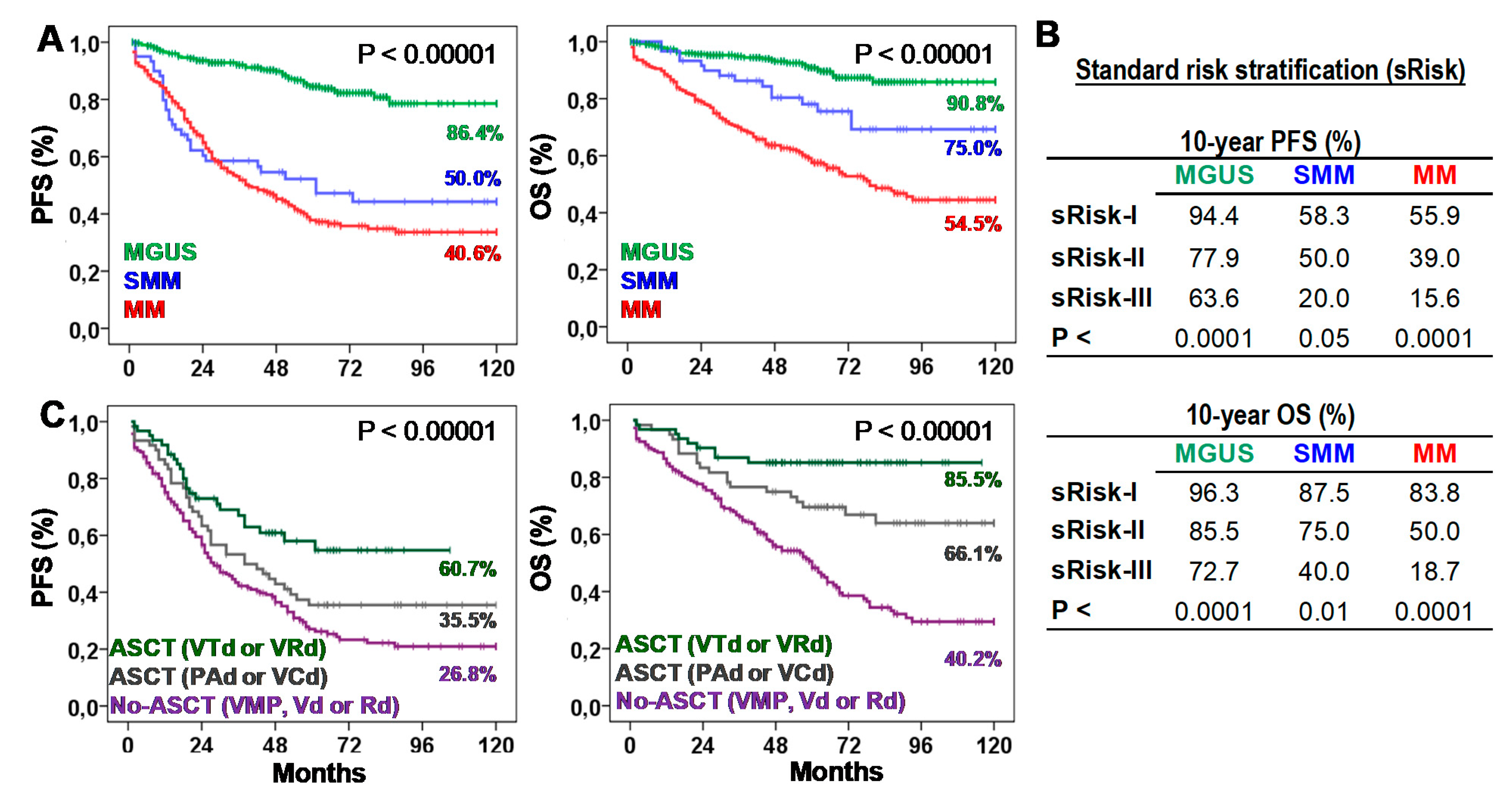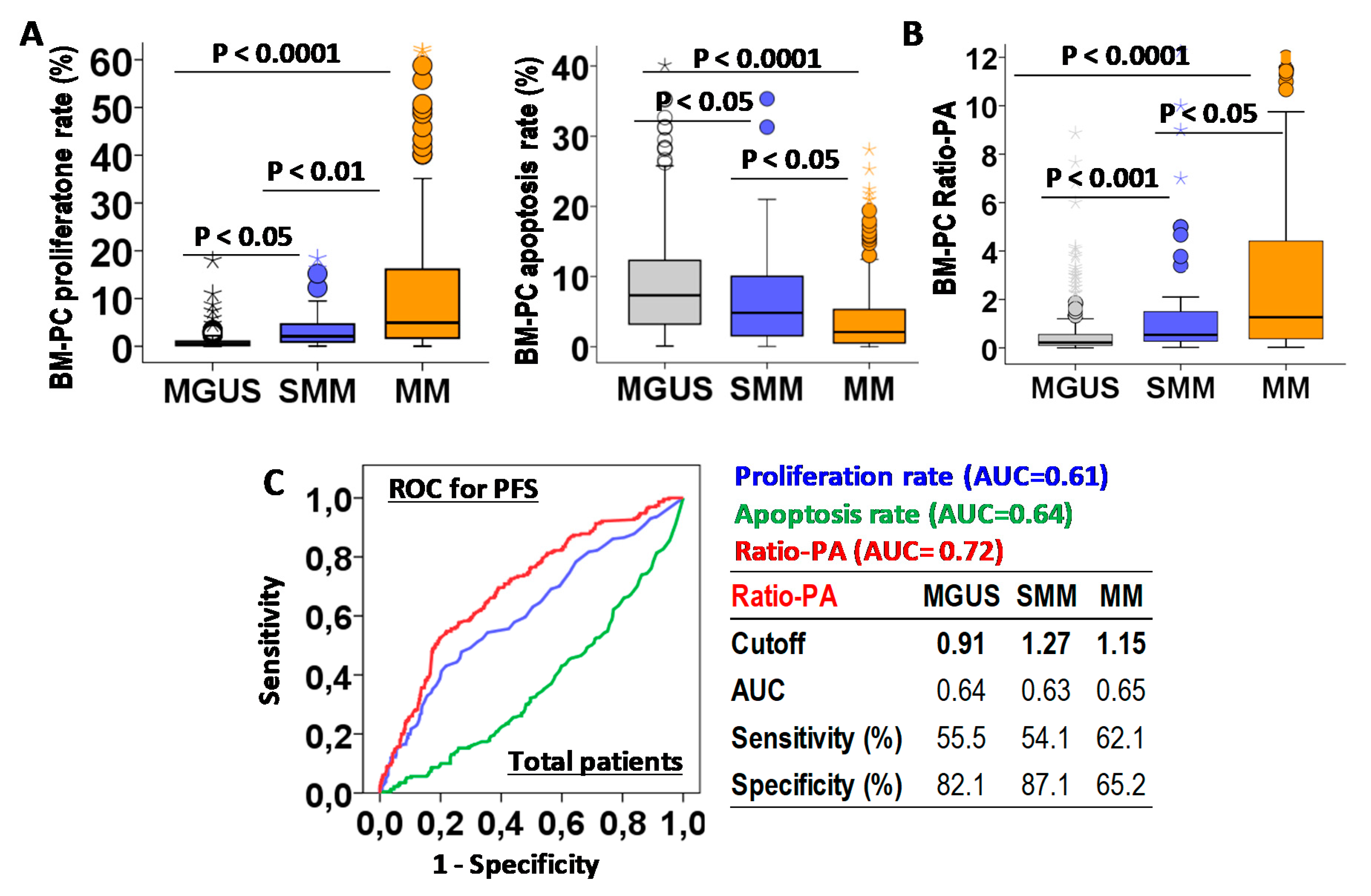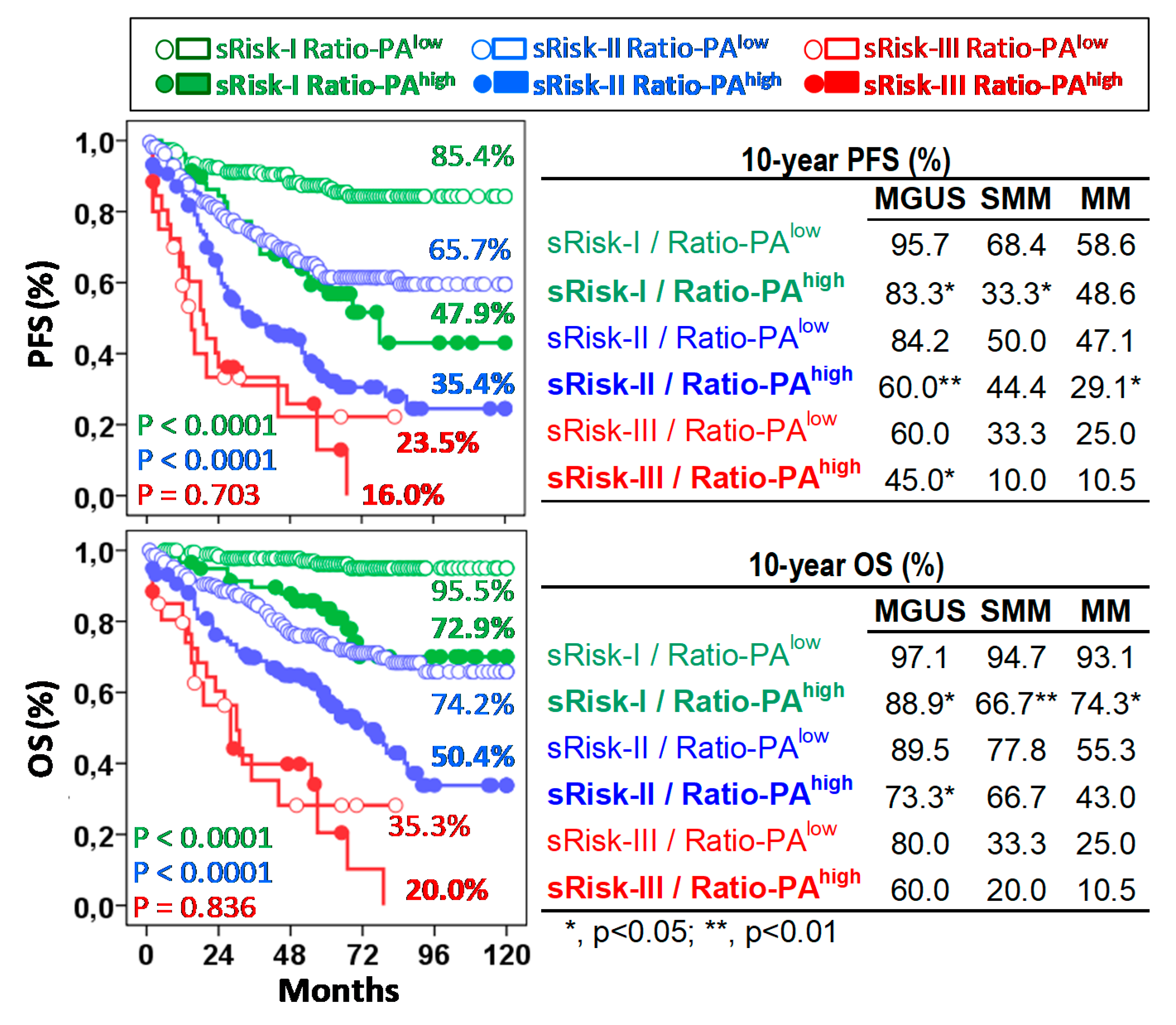Proliferation to Apoptosis Tumor Cell Ratio as a Biomarker to Improve Clinical Management of Pre-Malignant and Symptomatic Plasma Cell Neoplasms
Abstract
1. Introduction
2. Results
2.1. Patient Characteristics
2.2. Prognostic Value of BM-PC Proliferation to Apoptosis Ratio (Ratio-PA)
2.3. Ratio-PA Complements the Prognostic Capacity of Standard Risk Stratification in PCNs
2.4. Delays in BM Sample Processing Reduces the Prognostic Capacity of the Ratio-PA
2.5. Tandem ASCT with VTd or VRd Are the Most Effective First-Line Treatments for Patients with Ratio-PAhigh
3. Discussion
4. Patients and Methods
4.1. Patients and Samples
4.2. Immunophenotyping, MRD, Proliferation, and Apoptosis Analyses
4.3. Fluorescent In Situ Hybridization (FISH)
4.4. Statistical Analysis
Supplementary Materials
Author Contributions
Funding
Institutional Review Board Statement
Informed Consent Statement
Data Availability Statement
Acknowledgments
Conflicts of Interest
References
- San-Miguel, J.F.; Mateos, M.V. Can multiple myeloma become a curable disease? Haematologica 2011, 96, 1246–1248. [Google Scholar] [CrossRef] [PubMed]
- van de Donk, N.W.C.J.; Mutis, T.; Poddighe, P.J.; Lokhorst, H.M.; Zweegman, S. Diagnosis, risk stratification and management of monoclonal gammopathy of undetermined significance and smoldering multiple myeloma. Int. J. Lab. Hematol. 2016, 38, 110–122. [Google Scholar] [CrossRef] [PubMed]
- Kyle, R.A.; Durie, B.G.M.; Rajkumar, S.V.; Landgren, O.; Blade, J.; Merlini, G.; Kröger, N.; Einsele, H.; Vesole, D.H.; Dimopoulos, M.; et al. Monoclonal gammopathy of undetermined significance (MGUS) and smoldering (asymptomatic) multiple myeloma: IMWG consensus perspectives risk factors for progression and guidelines for monitoring and management. Leukemia 2010, 24, 1121–1127. [Google Scholar] [CrossRef] [PubMed]
- Pérez-Persona, E.; Vidriales, M.-B.; Mateo, G.; García-Sanz, R.; Mateos, M.-V.; de Coca, A.G.; Galende, J.; Martín-Nuñez, G.; Alonso, J.M.; de Las Heras, N.; et al. New criteria to identify risk of progression in monoclonal gammopathy of uncertain significance and smoldering multiple myeloma based on multiparameter flow cytometry analysis of bone marrow plasma cells. Blood 2007, 110, 2586–2592. [Google Scholar] [CrossRef] [PubMed]
- Lakshman, A.; Rajkumar, S.V.; Buadi, F.K.; Binder, M.; Gertz, M.A.; Lacy, M.Q.; Dispenzieri, A.; Dingli, D.; Fonder, A.L.; Hayman, S.R.; et al. Risk stratification of smoldering multiple myeloma incorporating revised IMWG diagnostic criteria. Blood Cancer J. 2018, 8, 59. [Google Scholar] [CrossRef] [PubMed]
- Mateos, M.-V.; Kumar, S.; Dimopoulos, M.A.; González-Calle, V.; Kastritis, E.; Hajek, R.; De Larrea, C.F.; Morgan, G.J.; Merlini, G.; Goldschmidt, H.; et al. International Myeloma Working Group risk stratification model for smoldering multiple myeloma (SMM). Blood Cancer J. 2020, 10, 102. [Google Scholar] [CrossRef]
- Wu, V.; Moshier, E.; Leng, S.; Barlogie, B.; Cho, H.J.; Jagannath, S.; Madduri, D.; Mazumdar, M.; Parekh, S.; Chari, A. Risk stratification of smoldering multiple myeloma: Predictive value of free light chains and group-based trajectory modeling. Blood Adv. 2018, 2, 1470–1479. [Google Scholar] [CrossRef]
- Rajkumar, S.V. Multiple myeloma: 2018 update on diagnosis, risk-stratification, and management. Am. J. Hematol. 2018, 93, 1091–1110. [Google Scholar] [CrossRef]
- Wadhera, R.K.; Rajkumar, S.V. Prevalence of monoclonal gammopathy of undetermined significance: A systematic review. Mayo Clin. Proc. 2010, 85, 933–942. [Google Scholar] [CrossRef]
- Kyle, R.A.; Therneau, T.M.; Rajkumar, S.V.; Larson, D.R.; Plevak, M.F.; Offord, J.R.; Dispenzieri, A.; Katzmann, J.A.; Melton, L.J. Prevalence of monoclonal gammopathy of undetermined significance. N. Engl. J. Med. 2006, 354, 1362–1369. [Google Scholar] [CrossRef]
- Kyle, R.A.; Larson, D.R.; Therneau, T.M.; Dispenzieri, A.; Kumar, S.; Cerhan, J.R.; Rajkumar, S.V. Long-Term Follow-up of Monoclonal Gammopathy of Undetermined Significance. N. Engl. J. Med. 2018, 378, 241–249. [Google Scholar] [CrossRef]
- Kyle, R.A.; Remstein, E.D.; Therneau, T.M.; Dispenzieri, A.; Kurtin, P.J.; Hodnefield, J.M.; Larson, D.R.; Plevak, M.F.; Jelinek, D.F.; Fonseca, R.; et al. Clinical course and prognosis of smoldering (asymptomatic) multiple myeloma. N. Engl. J. Med. 2007, 356, 2582–2590. [Google Scholar] [CrossRef]
- Gagelmann, N.; Eikema, D.-J.; Koster, L.; Caillot, D.; Pioltelli, P.; Lleonart, J.B.; Reményi, P.; Blaise, D.; Schaap, N.; Trneny, M.; et al. Tandem Autologous Stem Cell Transplantation Improves Outcomes in Newly Diagnosed Multiple Myeloma with Extramedullary Disease and High-Risk Cytogenetics: A Study from the Chronic Malignancies Working Party of the European Society for Blood and Marrow Tran. Biol. Blood Marrow Transplant. 2019, 25, 2134–2142. [Google Scholar] [CrossRef]
- Scudla, V.; Ordeltova, M.; Minarik, J.; Dusek, L.; Zemanova, M.; Bacovsky, J. Prognostic significance of plasma cell propidium iodide and annexin-V indices and their mutual ratio in multiple myeloma. Neoplasma 2006, 53, 213–218. [Google Scholar]
- Minarik, J.; Scudla, V.; Ordeltova, M.; Pika, T.; Bacovsky, J.; Steinbach, M.; Kumar, V.; Van Ness, B. Combined measurement of plasma cell proliferative and apoptotic index in multiple myeloma defines patients with good and poor prognosis. Leuk. Res. 2011, 35, 44–48. [Google Scholar] [CrossRef]
- Minarík, J.; Scudla, V.; Ordeltová, M.; Bacovský, J.; Zemanová, M. Evaluation of plasma cell propidium-iodide and annexin-V indices: Their relation to prognosis in multiple myeloma. Biomed. Pap. Med. Fac. Univ. Palacky. Olomouc. Czech. Repub. 2005, 149, 271–274. [Google Scholar] [CrossRef]
- Madan, S.; Kyle, R.A.; Greipp, P.R. Plasma cell labeling index in the evaluation of smoldering (asymptomatic) multiple myeloma. Mayo Clin. Proc. 2010, 85, 300. [Google Scholar] [CrossRef] [PubMed]
- Aljama, M.A.; Sidiqi, M.H.; Lakshman, A.; Dispenzieri, A.; Jevremovic, D.; Gertz, M.A.; Lacy, M.Q.; Buadi, F.K.; Dingli, D.; Muchtar, E.; et al. Plasma cell proliferative index is an independent predictor of progression in smoldering multiple myeloma. Blood Adv. 2018, 2, 3149–3154. [Google Scholar] [CrossRef] [PubMed]
- Dhodapkar, M.V.; Sexton, R.; Waheed, S.; Usmani, S.; Papanikolaou, X.; Nair, B.; Petty, N.; Shaughnessy, J.D.; Hoering, A.; Crowley, J.; et al. Clinical, genomic, and imaging predictors of myeloma progression from asymptomatic monoclonal gammopathies (SWOG S0120). Blood 2014, 123, 78–85. [Google Scholar] [CrossRef] [PubMed]
- Oancea, M.; Mani, A.; Hussein, M.A.; Almasan, A. Apoptosis of multiple myeloma. Int. J. Hematol. 2004, 80, 224–231. [Google Scholar] [CrossRef]
- Spets, H.; Strömberg, T.; Georgii-Hemming, P.; Siljason, J.; Nilsson, K.; Jernberg-Wiklund, H. Expression of the bcl-2 family of pro- and anti-apoptotic genes in multiple myeloma and normal plasma cells: Regulation during interleukin-6(IL-6)-induced growth and survival. Eur. J. Haematol. 2002, 69, 76–89. [Google Scholar] [CrossRef]
- Holstein, S.A.; McCarthy, P.L. Immunomodulatory Drugs in Multiple Myeloma: Mechanisms of Action and Clinical Experience. Drugs 2017, 77, 505–520. [Google Scholar] [CrossRef]
- Mitsiades, N.; Mitsiades, C.S.; Poulaki, V.; Chauhan, D.; Fanourakis, G.; Gu, X.; Bailey, C.; Joseph, M.; Libermann, T.A.; Treon, S.P.; et al. Molecular sequelae of proteasome inhibition in human multiple myeloma cells. Proc. Natl. Acad. Sci. USA 2002, 99, 14374–14379. [Google Scholar] [CrossRef] [PubMed]
- Liu, S.; Edgerton, S.M.; Moore, D.H.; Thor, A.D. Measures of cell turnover (proliferation and apoptosis) and their association with survival in breast cancer. Clin. Cancer Res. 2001, 7, 1716–1723. [Google Scholar] [PubMed]
- Scudla, V.; Ordeltova, M.; Bacovsky, J.; Vytrasova, M.; Sumna, E.; Martinek, A.; Horak, P. A contribution to examination of propidium iodide and annexin V plasma cells indices in multiple myeloma. Neoplasma 2003, 50, 363–371. [Google Scholar]
- Leung, T.-W.; Xue, W.-C.; Cheung, A.N.Y.; Khoo, U.-S.; Ngan, H.Y.S. Proliferation to apoptosis ratio as a prognostic marker in adenocarcinoma of uterine cervix. Gynecol. Oncol. 2004, 92, 866–872. [Google Scholar] [CrossRef] [PubMed]
- Kuriyama, H.; Lamborn, K.R.; O’Fallon, J.R.; Iturria, N.; Sebo, T.; Schaefer, P.L.; Scheithauer, B.W.; Buckner, J.C.; Kuriyama, N.; Jenkins, R.B.; et al. Prognostic significance of an apoptotic index and apoptosis/proliferation ratio for patients with high-grade astrocytomas. Neuro Oncol. 2002, 4, 179–186. [Google Scholar] [CrossRef][Green Version]
- Witzig, T.E.; Timm, M.; Larson, D.; Therneau, T.; Greipp, P.R. Measurement of apoptosis and proliferation of bone marrow plasma cells in patients with plasma cell proliferative disorders. Br. J. Haematol. 1999, 104, 131–137. [Google Scholar] [CrossRef]
- Scudla, V.; Vlastimil, M.; Ordeltova, M.; Bacovsky, J.; Vytrasova, M.; Horak, P.; Minarik, J. The relationship between proliferation and apoptosis in patients with monoclonal gammopathy of undetermined significance or multiple myeloma. Haematologica 2005, 90, 1713–1714. [Google Scholar]
- Rajkumar, S.V.; Kyle, R.A.; Buadi, F.K. Advances in the diagnosis, classification, risk stratification, and management of monoclonal gammopathy of undetermined significance: Implications for recategorizing disease entities in the presence of evolving scientific evidence. Mayo Clin. Proc. 2010, 85, 945–948. [Google Scholar] [CrossRef]
- Boccadoro, M.; Marmont, F.; Tribalto, M.; Fossati, G.; Redoglia, V.; Battaglio, S.; Massaia, M.; Gallamini, A.; Comotti, B.; Barbui, T. Early responder myeloma: Kinetic studies identify a patient subgroup characterized by very poor prognosis. J. Clin. Oncol. 1989, 7, 119–125. [Google Scholar] [CrossRef]
- San Miguel, J.F.; García-Sanz, R.; González, M.; Moro, M.J.; Hernández, J.M.; Ortega, F.; Borrego, D.; Carnero, M.; Casanova, F.; Jiménez, R. A new staging system for multiple myeloma based on the number of S-phase plasma cells. Blood 1995, 85, 448–455. [Google Scholar] [CrossRef] [PubMed]
- Trendle, M.C.; Leong, T.; Kyle, R.A.; Katzmann, J.A.; Oken, M.M.; Kay, N.E.; Van Ness, B.G.; Greipp, P.R. Prognostic significance of the S-phase fraction of light-chain-restricted cytoplasmic immunoglobulin (cIg) positive plasma cells in patients with newly diagnosed multiple myeloma enrolled on Eastern Cooperative Oncology Group treatment trial E9486. Am. J. Hematol. 1999, 61, 232–237. [Google Scholar] [CrossRef]
- Steensma, D.P.; Gertz, M.A.; Greipp, P.R.; Kyle, R.A.; Lacy, M.Q.; Lust, J.A.; Offord, J.R.; Plevak, M.F.; Therneau, T.M.; Witzig, T.E. A high bone marrow plasma cell labeling index in stable plateau-phase multiple myeloma is a marker for early disease progression and death. Blood 2001, 97, 2522–2523. [Google Scholar] [CrossRef] [PubMed]
- Vacca, A.; Ribatti, D.; Roncali, L.; Dammacco, F. Angiogenesis in B cell lymphoproliferative diseases. Biological and clinical studies. Leuk. Lymphoma 1995, 20, 27–38. [Google Scholar] [CrossRef] [PubMed]
- Cavo, M.; Pantani, L.; Petrucci, M.T.; Patriarca, F.; Zamagni, E.; Donnarumma, D.; Crippa, C.; Boccadoro, M.; Perrone, G.; Falcone, A.; et al. Bortezomib-thalidomide-dexamethasone is superior to thalidomide-dexamethasone as consolidation therapy after autologous hematopoietic stem cell transplantation in patients with newly diagnosed multiple myeloma. Blood 2012, 120, 9–19. [Google Scholar] [CrossRef] [PubMed]
- Sidiqi, M.H.; Aljama, M.A.; Jevremovic, D.; Morice, W.G.; Timm, M.; Buadi, F.K.; Warsame, R.; Lacy, M.Q.; Dispenzieri, A.; Dingli, D.; et al. Plasma cell proliferative index post-transplant is a powerful predictor of prognosis in myeloma patients failing to achieve a complete response. Bone Marrow Transplant. 2019, 54, 442–447. [Google Scholar] [CrossRef]
- Kastritis, E.; Terpos, E.; Moulopoulos, L.; Spyropoulou-Vlachou, M.; Kanellias, N.; Eleftherakis-Papaiakovou, E.; Gkotzamanidou, M.; Migkou, M.; Gavriatopoulou, M.; Roussou, M.; et al. Extensive bone marrow infiltration and abnormal free light chain ratio identifies patients with asymptomatic myeloma at high risk for progression to symptomatic disease. Leukemia 2013, 27, 947–953. [Google Scholar] [CrossRef]
- Rajkumar, S.V.; Dimopoulos, M.A.; Palumbo, A.; Blade, J.; Merlini, G.; Mateos, M.V.; Kumar, S.; Hillengass, J.; Kastritis, E.; Richardson, P.; et al. International Myeloma Working Group updated criteria for the diagnosis of multiple myeloma. Lancet Oncol. 2014, 15, e538–e548. [Google Scholar] [CrossRef]
- Zhao, A.-L.; Shen, K.-N.; Wang, J.-N.; Huo, L.-Q.; Li, J.; Cao, X.-X. Early or deferred treatment of smoldering multiple myeloma: A meta-analysis on randomized controlled studies. Cancer Manag. Res. 2019, 11, 5599–5611. [Google Scholar] [CrossRef]
- Hernández, J.-Á.; Martínez-López, J.; Lahuerta, J.-J. Timing treatment for smoldering myeloma: Is earlier better? Expert Rev. Hematol. 2019, 12, 345–354. [Google Scholar] [CrossRef]
- Kapoor, P.; Rajkumar, S.V. Smoldering Multiple Myeloma: To Treat or Not to Treat. Cancer J. 2015, 25, 65–71. [Google Scholar] [CrossRef] [PubMed]
- Mateos, M.-V.; Hernández, M.-T.; Giraldo, P.; de la Rubia, J.; de Arriba, F.; López Corral, L.; Rosiñol, L.; Paiva, B.; Palomera, L.; Bargay, J.; et al. Lenalidomide plus dexamethasone for high-risk smoldering multiple myeloma. N. Engl. J. Med. 2013, 369, 438–447. [Google Scholar] [CrossRef] [PubMed]
- van de Donk, N.W.C.J.; Niels, W.C.J.; Palumbo, A.; Johnsen, H.E.; Engelhardt, M.; Gay, F.; Gregersen, H.; Hajek, R.; Kleber, M.; Ludwig, H.; et al. The clinical relevance and management of monoclonal gammopathy of undetermined significance and related disorders: Recommendations from the European Myeloma Network. Haematologica 2014, 99, 984–996. [Google Scholar] [CrossRef] [PubMed]
- Durie, B.G.M.; Harousseau, J.L.; Miguel, J.S.; Bladé, J.; Barlogie, B.; Anderson, K.; Gertz, M.; Dimopoulos, M.; Westin, J.; Sonneveld, P.; et al. International uniform response criteria for multiple myeloma. Leukemia 2006, 20, 1467–1473. [Google Scholar] [CrossRef] [PubMed]
- Flores-Montero, J.; Sanoja-Flores, L.; Paiva, B.; Puig, N.; García-Sánchez, O.; Böttcher, S.; Van Der Velden, V.H.J.; Pérez-Morán, J.J.; Vidriales, M.B.; García-Sanz, R.; et al. Next Generation Flow for highly sensitive and standardized detection of minimal residual disease in multiple myeloma. Leukemia 2017, 31, 2094–2103. [Google Scholar] [CrossRef]
- Kumar, S.; Paiva, B.; Anderson, K.C.; Durie, B.; Landgren, O.; Moreau, P.; Munshi, N.; Lonial, S.; Bladé, J.; Mateos, M.V.; et al. International Myeloma Working Group consensus criteria for response and minimal residual disease assessment in multiple myeloma. Lancet Oncol. 2016, 17, e328–e346. [Google Scholar] [CrossRef]







| MGUS (n = 316) | SMM (n = 57) | MM (n = 266) | |
|---|---|---|---|
| Demographic, Biochemical and Immunological Characteristics | |||
| Age, years, Mean ± SEM | 67.4 ± 0.7 | 67.5 ± 1.6 | 67.6 ± 0.7 |
| Female, n (%) | 143 (45.3%) | 34 (59.6%) | 130 (48.9%) |
| Hemoglobin, g/dL, Mean ± SEM | 14.3 ± 5.7 | 12.9 ± 2.51 | 10.8 ± 1.7 *** |
| Serum calcium, g/dL, Mean ±S EM | 9.45 ± 0.04 | 9.46 ± 0.11 | 9.70 ± 0.09 ** |
| Serum creatinine, mg/dL, Mean ± SEM | 1.20 ± 0.07 | 1.04 ± 0.07 | 1.73 ± 0.13 * |
| Serum albumin < 3.5 g/dL, n (%) | 29 (9.2%) | 6 (10.5%) | 91 (34.2%) *** |
| Serum 2-microglobulin ≥ 3.5 mg/dL, n (%) | 93 (29.4%) | 18 (31.5%) | 159 (59.8%) *** |
| LDH ≥ upper limit of normal, n (%) | 52 (16.4%) | 9 (15.7%) | 59 (22.2%) |
| Serum M-protein, g/dL, Mean ± SEM | 1.04 ± 0.08 | 1.68 ± 0.13 * | 2.81 ± 0.20 *** |
| Bence Jones protein, n (%) | 106 (33.5%) | 30 (52.6%) * | 186 (69.9%) *** |
| Free light chain ratio > 20, n (%) | 109 (34.5%) | 32 (56.1%) ** | 195 (73.3%) *** |
| IgG gammopathy, n (%) | 227 (71.8%) | 33 (57.9%) * | 143 (53.7%) *** |
| Immunoparesis, n (%) | 111 (35.1%) | 35 (61.4%) *** | 242 (90.9%) *** |
| Bone Marrow Plasma Cells (BM-PC) Counts | |||
| Total BM-PC histology, % (Mean ± SEM) | 4.71 ± 0.16 | 16.85 ± 1.5 *** | 33.52 ± 1.6 *** |
| Total BM-PC flow cytometry, % (Mean ± SEM) | 1.08 ± 0.09 | 3.54 ± 0.54 | 13.01 ± 1.5 *** |
| Fluorescent In Situ Hybridization (FISH) on Purified BM-PCs | |||
| del(17p), n (%) | 3 (0.9%) | 2 (3.5%) | 23 (8.6%) *** |
| t(4;14) or t(14;16), n (%) | 2 (0.7%) | 2 (3.5%) | 14 (5.2%) ** |
| Gain of 1q21 | 35 (11.0%) | 17 (30.0%) ** | 115 (43.2%) *** |
| Other alterations, n (%) 1 | 32 (10.1%) | 7 (12.3%) | 51 (20.3%) ** |
| No abnormalities, n (%) | 253 (80.1%) | 30 (52.6%) ** | 77 (28.9%) *** |
| Not available, n (%) | 55 (17.4%) | 1 (1.75%) * | 35 (13.15%) |
| Clinical Characteristics | |||
| Osteolytic lesions, n (%) | 8 (2.5%) | 4 (7.0%) | 147 (55.3%) *** |
| Renal insufficiency, n (%) | 85 (26.9%) | 14 (24.50%) | 97 (36.4%) * |
| Additional cardio-respiratory diseases, n (%) | 81 (25.6%) | 15 (26.3%) | 80 (30.1%) |
| Additional endocrine diseases, n (%) | 72 (22.8%) | 16 (28.1%) | 63 (23.7%) |
| Additional rheumatologic diseases, n (%) | 34 (10.7%) | 4 (7.01%) | 12 (4.5%) |
| Additional oncological malignances, n (%) | 23 (7.2%) | 7 (12.3%) | 25 (10.1%) |
| Additional hematological diseases, n (%) | 14 (5.1%) | 5 (8.9%) | 27 (10.3%) |
| Risk stratification Low/Intermediate/High, n 2 | 152/142/11 | 26/28/6 | 65/165/32 |
| Treatments 3 | |||
| No ASCT with VMP, Vd or Rd, n (%) | 17 (5.3%) 4 | 10 (17.5%) 4 | 149 (56.1%) |
| ASCT with PAD or VCD, n (%) | 0 (0.0%) | 3 (5.3%) 4 | 57 (21.4%) |
| ASCT with VTd or VRd, n (%) | 2 (0.6%) 4 | 11 (19.3%) 4 | 48 (18.0%) |
| Palliative | - | - | 12 (4.5%) |
Publisher’s Note: MDPI stays neutral with regard to jurisdictional claims in published maps and institutional affiliations. |
© 2021 by the authors. Licensee MDPI, Basel, Switzerland. This article is an open access article distributed under the terms and conditions of the Creative Commons Attribution (CC BY) license (https://creativecommons.org/licenses/by/4.0/).
Share and Cite
Vasco-Mogorrón, M.A.; Campillo, J.A.; Periago, A.; Cabañas, V.; Berenguer, M.; García-Garay, M.C.; Gimeno, L.; Soto-Ramírez, M.F.; Martínez-Hernández, M.D.; Muro, M.; et al. Proliferation to Apoptosis Tumor Cell Ratio as a Biomarker to Improve Clinical Management of Pre-Malignant and Symptomatic Plasma Cell Neoplasms. Int. J. Mol. Sci. 2021, 22, 3895. https://doi.org/10.3390/ijms22083895
Vasco-Mogorrón MA, Campillo JA, Periago A, Cabañas V, Berenguer M, García-Garay MC, Gimeno L, Soto-Ramírez MF, Martínez-Hernández MD, Muro M, et al. Proliferation to Apoptosis Tumor Cell Ratio as a Biomarker to Improve Clinical Management of Pre-Malignant and Symptomatic Plasma Cell Neoplasms. International Journal of Molecular Sciences. 2021; 22(8):3895. https://doi.org/10.3390/ijms22083895
Chicago/Turabian StyleVasco-Mogorrón, María A., José A. Campillo, Adela Periago, Valentin Cabañas, Mercedes Berenguer, María C. García-Garay, Lourdes Gimeno, María F. Soto-Ramírez, María D. Martínez-Hernández, Manuel Muro, and et al. 2021. "Proliferation to Apoptosis Tumor Cell Ratio as a Biomarker to Improve Clinical Management of Pre-Malignant and Symptomatic Plasma Cell Neoplasms" International Journal of Molecular Sciences 22, no. 8: 3895. https://doi.org/10.3390/ijms22083895
APA StyleVasco-Mogorrón, M. A., Campillo, J. A., Periago, A., Cabañas, V., Berenguer, M., García-Garay, M. C., Gimeno, L., Soto-Ramírez, M. F., Martínez-Hernández, M. D., Muro, M., & Minguela, A. (2021). Proliferation to Apoptosis Tumor Cell Ratio as a Biomarker to Improve Clinical Management of Pre-Malignant and Symptomatic Plasma Cell Neoplasms. International Journal of Molecular Sciences, 22(8), 3895. https://doi.org/10.3390/ijms22083895








